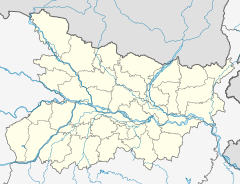
The Srikalahasti Temple is located in the town of Srikalahasti, in Tirupati district in the state of Andhra Pradesh, India. According to regional tradition, it is said to be the site where Kannappa was ready to offer both his eyes to cover blood flowing from the linga before Shiva stopped him and granted him moksha. The inner temple was constructed around the 5th century and the outer temple was constructed in the 11th century by the Rajendra Chola I and other Chola emperors such as Rajaditya Chola, Rajaraja Chola I, Rajadhiraja Chola I, Kulottunga Chola I, Kulottunga Chola III. Shiva in his aspect as Vayu is worshipped as Kalahasteeswara. The temple is also regarded as Rahu-Ketu kshetra and Dakshina Kailasam.

Gupteswar Cave is a cave shrine dedicated to Shiva. It is a pilgrim site situated about 55 km (34 mi) away Jeypore, Koraput District in the state of Odisha, India. It is a limestone cave, and its main attraction is the gigantic Shiva Linga which is said to be increasing in size. It is believed that the cave was discovered by Rama and re-discovered in the reign of Maharajah Veer Vikram Dev. In the holy month of Shravan, the cave is visited by devotees who walk to the shrine bare-footed with decorated bamboo palanquins called "Kanwadiya" and bathe in the maha kund before worshipping Lord Gupteshwar. There are 200 steps to reach to the Shiva linga temple. Its entrance is about 3 metres (9.8 ft) wide and 2 metres (6.6 ft) high.
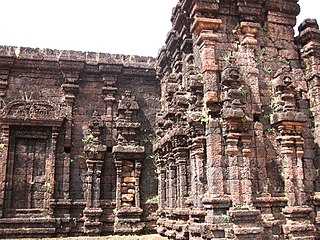
The Rajarajeshwara temple is a Shiva temple located in Taliparamba in Kannur district of Kerala State of India. The temple is regarded as one of the existing 108 ancient Shiva Temples of ancient Kerala. It also has a prominent place amongst the numerous Shiva temples in South India. It had the tallest shikhara amongst the temples of its time. The Rajarajeshwara temple has a top of about 90 tonnes. If any problem is encountered in the other temples of South India, devotees seek a solution in this temple through a prashnam, a traditional method of astrological decision-making. The prashnam is conducted on a peedha outside the temple.

Gokarna is a small temple town located in the Uttara Kannada district of Karnataka state in southern India, It has a population of around 20,000. Shiva is the most worshipped deity in the town. Gokarna's main temple, Mahabaleshwara, is dedicated to Shiva. The temple houses what is believed by some to be the earliest Shiva lingam (Atmalinga).

Shiva Puja in Hinduism is the way by which one worships Shiva through traditional and ancient rites with the use of mantra, tantra, yantra, kriyas, mudras, and abhishekam.
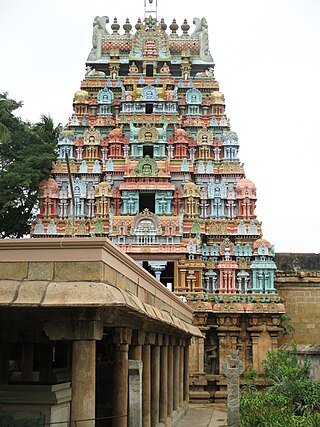
Jambukeswarar Temple, Thiruvanaikaval is a temple of Shiva in Tiruchirapalli district, in the state of Tamil Nadu, India. It is one of the five major Shiva Temples of Tamil Nadu representing the Mahābhūta or five elements; this temple represents the element of water, or neer in Tamil. The sanctum of Jambukeswara has an underground stream.
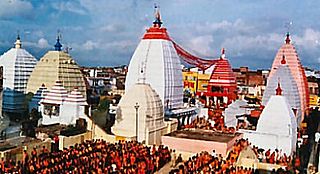
Baidyanath Temple, also known as Baba Baidyanath Dham, is a Hindu temple dedicated to Shiva. It is located in Deoghar, in the Santhal Parganas division of the Indian state of Jharkhand. The temple complex comprises the central shrine of Baba Baidyanath along with 21 additional temples. It is significant to the Hindu sects of Shaivism as this temple is referred to as one of the twelve Jyotirlingas.
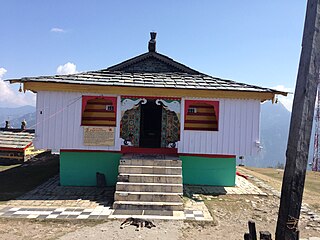
Bijali Mahadeva Mandir is a located in Kashawri village, Kullu Valley in the Indian state of Himachal Pradesh. It is located at an altitude of about 2,460m in the Kullu Valley. Bijli Mahadev is one of the ancient temples in India and dedicated to Lord Shiva (Mahadev). Located 14 km from Kullu across the Beas river, it can be approached by a rewarding trek of 3 km.

Banalinga, a stone found in nature, in the bed of the Narmada river in Madhya Pradesh state, India, is an iconic symbol of worship, based on either the scriptures or cultural traditions among the Hindus, particularly of the Shaivas and Smarta Brahmins. It is a smooth ellipsoid stone that represents a lingam, an anionic form of the deity Shiva.
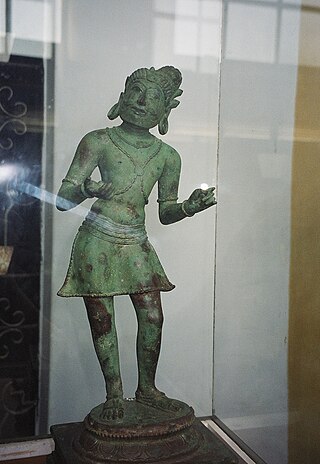
Kannappa is a legendary figure in Tamil, and more broadly Hindu, folklore who was a devoted follower of the Hindu god Shiva. He is closely associated with the Srikalahasteeswara Temple in Andhra Pradesh, India. According to the folktale, Kannappa, originally a hunter, plucked out one of his eyes as an offering to a lingam. However, before he could pluck out the second eye, Shiva intervened. He is revered as one of the 63 Nayanars, a group of Shaiva saints.
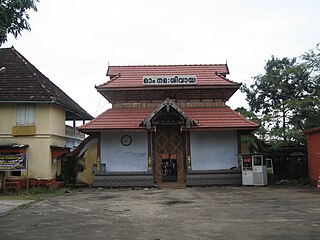
Ernakulam Shiva Temple, also known as Ernakulathappan Temple is one of the major temples of Kerala, located in heart of Ernakulam, Kochi,Kerala, India. The temple, dedicated to Lord Shiva, is considered as the city temple, with the presiding deity as the protector of the city, as per local Hindu faiths and traditions. As per the common practice in Kerala, the deity is reverently called Ernakulathappan, which means Lord of Ernakulam. The temple is located within the Durbar Hall Ground. The temple history itself has deep association with history of the city and was one of the 7 royal temples of Kochi Maharajas. The temple is now under administration of Cochin Devaswam Board. The temple in its current form was built under active patronage of Diwan Sri Edakkunni Sankara Warrier in year 1846 and raised it level of a Royal temple in the Kochi Kingdom. The temple is built on 1-acre (4,000 m2) land. The temple is one of the major Shiva temples in Kerala counted along with the Ettumanoor Mahadevar Temple, Kaduthruthy Mahadeva Temple, Vaikom Temple, Chengannur Mahadeva Temple, Vadakkunathan temple, and Sreekanteswaram Mahadeva Temple, Thiruvananthapuram.

Sri Bhramaramba Mallikarjuna Temple or Srisailam Temple is a Hindu temple dedicated to the deities Shiva and Parvati, located at Srisailam in the Indian state of Andhra Pradesh.

A Jyotirlinga or Jyotirlingam, is a devotional representation of the Hindu god Shiva. The word is a Sanskrit compound of jyotis ('radiance') and linga ('sign'). The Śiva Mahāpurāṇam mentions 64 original jyotirlinga shrines in India.

The Karaneeswarar Temple is a 12th-century Hindu temple in the neighbourhood of Mylapore in Chennai, India. The temple is dedicated to Shiva as Karaneeswarar. There are also shrines to Sarvamangala Vinayaka (Ganesha), Dandapani (Kartikeya), Durga, Lakshmi and Saraswati.
In religion and spirituality, a pilgrimage is a very long journey or search of great moral significance. Sometimes, it is a journey to a sacred area or shrine of importance to innate faith. Members of every major religion participate in pilgrimages. A person who makes such a journey is called a pilgrim.

In Hinduism, Rasalingam or Parad Lingam is a Lingam, the symbol of the god Shiva, made of mercury Tamil Siddhas carved Shiva Lingam from solidified mercury. The process of solidification of mercury is the secret process enunciated by Tamil Siddhas. In Tamil, mercury is called Pada-rasam and the Shiva Lingam made using pada-rasam is called Rasalingam. In Sanskrit, mercury is called Parad and the Shiva Lingam made using parad is called Parad Lingam. Rasalingams or Parad Lingams are consecrated in Hindu Shiva temples, Ashrams and other places of worships.

The Pataleshwar Mandir is a Hindu Temple in the city of Hajipur, Bihar, India. Dedicated to Shiva, it is located at Jadhua Road, Hajipur. As per local folklore, it is said to have been in existence since ancient period and Lord Shiva is believed to be in the form of Lingam here. Apart from anthropomorphic images of Shiva, the worship of Shiva in the form of a lingam, or linga, is also important. The worship of the Shiva-Linga originated from the famous hymn in the Atharva-Veda Samhitâ sung in praise of the Yupa-Stambha, the sacrificial post.

A lingam, sometimes referred to as linga or Shiva linga, is an abstract or aniconic representation of the Hindu god Shiva in Shaivism. It is typically the primary murti or devotional image in Hindu temples dedicated to Shiva, also found in smaller shrines, or as self-manifested natural objects. It is often represented within a disc-shaped platform, the yoni – its feminine counterpart, consisting of a flat element, horizontal compared to the vertical lingam, and designed to allow liquid offerings to drain away for collection. Together, they symbolize the merging of microcosmos and macrocosmos, the divine eternal process of creation and regeneration, and the union of the feminine and the masculine that recreates all of existence.
